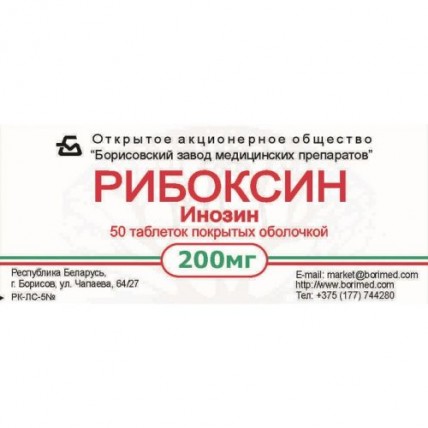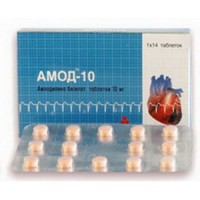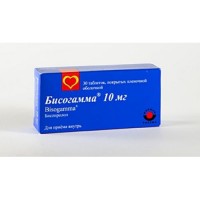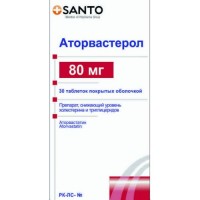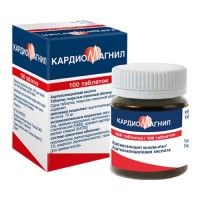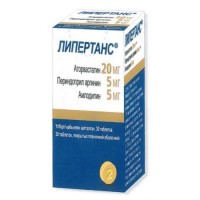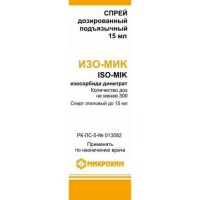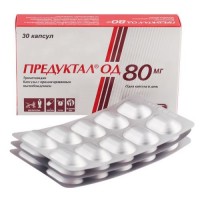Riboxin (Inosine) 200 mg, 50 tablets
- $6.00
The instruction for medical use
of INOSINE medicine
the Trade name
Inosine
the International unlicensed
name Inosine Dosage Form
of the Tablet, coated 200 mg
Structure
One tablet contains
active agent – inosine (in terms of 100% substance) – 200 mg,
excipients: potato starch, povidone, icing sugar, stearic acid, opadray II (contains: the polyvinyl alcohol which is partially hydrolyzed, talc, a macrogoal 3350), the painting pigment of yellow color (E 171 dioxide, ferrous oxide yellow E 172, aluminum varnish on the basis of yellow quinolinic E 104 supports the titan.
The description
of the Tablet, coated, yellow color, with a biconvex surface. On cross section two layers are visible.
Pharmacotherapeutic group
Other cardiotonic drugs.
The ATX C01EB code
the Pharmacological
Pharmacokinetics Well properties is absorbed in digestive tract. It is metabolized in a liver with formation of glucuronic acid and the subsequent its oxidation. In insignificant quantity it is allocated with kidneys.
The pharmacodynamics
Metabolic means, the predecessor of adenosine triphosphate, has anti-hypoxemic, metabolic and antiarrhytmic effect. Increases power balance of a myocardium, improves coronary circulation, prevents consequences of intraoperative ischemia of kidneys. Is directly involved in exchange of glucose and promotes activization of exchange in the conditions of a hypoxia and in the absence of adenosine triphosphate.
Activates metabolism of pyruvic acid for ensuring normal process of tissue respiration and also activation is promoted by xanthine-dehydrogenase. Stimulates synthesis of nucleotides, enhances activity of some enzymes of a tricarbonic acid cycle. Getting into cells, increases energy level, has positive effect on processes of exchange in a myocardium, increases force of reductions of heart and promotes fuller relaxation of a myocardium in a diastole therefore the stroke output of blood increases.
Reduces aggregation of thrombocytes, activates angenesis (especially a myocardium and a mucous membrane of digestive tract).
Indications
- myocardites
- myocardial dystrophies, connected with a physical overwork, the postponed infectious diseases, endocrine disturbances (thyrocardiac heart)
- prevention of the arrhythmias connected with overdose of cardiac glycosides
- acute and chronic hepatitises, cirrhosis (as a part of combination therapy)
- a preparation for surgery on an ischemic kidney
- prevention of a leukopenia at radiation therapy, radiation sickness
- a porphyria
Apply the Route of administration and doses inside to food.
The adult appoint 600 – 2400 mg in a daily dose. Treatment there begin with use 200 mg 3 - 4 times a day. In the absence of undesirable action, in 2 - 3 days the dose is raised to 400 mg by 3 times a day. Continuing increase in a dose each 2 - 3 days, pass to intake of Inosine in a dose 400 mg 4 times a day in the beginning, and then – 6 times a day. The course of treatment makes 1 - 3 month.
At aggravation of a porphyria, Inosine is appointed on 400 mg by 4 times a day daily within 1 - 3 months.
Side effects
- a hyperuricemia
- exacerbation of gout (at long reception of high doses)
- allergic reactions: the skin itching,
the Contraindication dermahemia
- gout
- hypersensitivity to Inosine
- bradyarrhythmia 2 – 3 degrees
- a syndrome of weakness of sinus node
- WPW – a syndrome, Morganya's symptom – Adams – Stokes
- children's and teenage age up to 18 years
Medicinal interactions
Enhances effects of anabolic steroids and nonsteroid anabolic means at simultaneous use.
Weakens broncholitic effect of theophylline and psychogogic effect of caffeine.
Special instructions
the Extra care when prescribing Riboksin's has to be observed at patients with renal failures. At the same time it is recommended to control the level of uric acid and urea in blood.
Use at a leukopenia
Riboksin's Use is not recommended at severe forms of a leukopenia, at the level of neutrophils of peripheral blood lower than 1.5 ×109 in liter.
Pregnancy and the period of a lactation
Inosine is appointed during pregnancy and a lactation taking into account advantage/risk.
Features of influence of medicines on ability to driving of motor transport and control of mechanisms
Intake of Inosine does not affect ability of the patient to control of the vehicle or other operator activity.
Overdose
in the presence of the phenomena of individual intolerance medicine is cancelled and carry out the desensibilizing therapy. Increase in level of uric acid in blood which at patients with gout leads to the aggravation demanding drug withdrawal is possible.
A form of release and packing
On 10 tablets in blister strip packaging from a film of the polyvinylchloride and printing aluminum foil varnished.
On 5 blister strip packagings together with the instruction for medical use in the state and Russian languages place in a pack from cardboard.
Storage conditions
In the dry, protected from light place, at a temperature not above 25ºС.
To store out of children's reach!
3 years
not to apply a period of storage after expiry date.
Prescription status
According to the prescription
the Borisovsky Plant of Medications Open joint stock company Producer, Republic of Belarus, Minsk Region, Borisov, Chapayev St., 64/27, ph. / fax 8-(10375177) 744280.
The owner of the registration certificate
Borisovsky Plant of Medications Open joint stock company, Republic of Belarus
the Address of the organization accepting in the territory of the Republic of Kazakhstan claims from consumers on quality of products (goods)
Borisovsky Plant of Medications Open joint stock company,
Republic of Belarus, Minsk Region, Borisov, Chapayev St., 64/27,
ph. / fax 8-(10375177) 744280, the e-mail address: market@borimed.com
of INOSINE medicine
the Trade name
Inosine
the International unlicensed
name Inosine Dosage Form
of the Tablet, coated 200 mg
Structure
One tablet contains
active agent – inosine (in terms of 100% substance) – 200 mg,
excipients: potato starch, povidone, icing sugar, stearic acid, opadray II (contains: the polyvinyl alcohol which is partially hydrolyzed, talc, a macrogoal 3350), the painting pigment of yellow color (E 171 dioxide, ferrous oxide yellow E 172, aluminum varnish on the basis of yellow quinolinic E 104 supports the titan.
The description
of the Tablet, coated, yellow color, with a biconvex surface. On cross section two layers are visible.
Pharmacotherapeutic group
Other cardiotonic drugs.
The ATX C01EB code
the Pharmacological
Pharmacokinetics Well properties is absorbed in digestive tract. It is metabolized in a liver with formation of glucuronic acid and the subsequent its oxidation. In insignificant quantity it is allocated with kidneys.
The pharmacodynamics
Metabolic means, the predecessor of adenosine triphosphate, has anti-hypoxemic, metabolic and antiarrhytmic effect. Increases power balance of a myocardium, improves coronary circulation, prevents consequences of intraoperative ischemia of kidneys. Is directly involved in exchange of glucose and promotes activization of exchange in the conditions of a hypoxia and in the absence of adenosine triphosphate.
Activates metabolism of pyruvic acid for ensuring normal process of tissue respiration and also activation is promoted by xanthine-dehydrogenase. Stimulates synthesis of nucleotides, enhances activity of some enzymes of a tricarbonic acid cycle. Getting into cells, increases energy level, has positive effect on processes of exchange in a myocardium, increases force of reductions of heart and promotes fuller relaxation of a myocardium in a diastole therefore the stroke output of blood increases.
Reduces aggregation of thrombocytes, activates angenesis (especially a myocardium and a mucous membrane of digestive tract).
Indications
- myocardites
- myocardial dystrophies, connected with a physical overwork, the postponed infectious diseases, endocrine disturbances (thyrocardiac heart)
- prevention of the arrhythmias connected with overdose of cardiac glycosides
- acute and chronic hepatitises, cirrhosis (as a part of combination therapy)
- a preparation for surgery on an ischemic kidney
- prevention of a leukopenia at radiation therapy, radiation sickness
- a porphyria
Apply the Route of administration and doses inside to food.
The adult appoint 600 – 2400 mg in a daily dose. Treatment there begin with use 200 mg 3 - 4 times a day. In the absence of undesirable action, in 2 - 3 days the dose is raised to 400 mg by 3 times a day. Continuing increase in a dose each 2 - 3 days, pass to intake of Inosine in a dose 400 mg 4 times a day in the beginning, and then – 6 times a day. The course of treatment makes 1 - 3 month.
At aggravation of a porphyria, Inosine is appointed on 400 mg by 4 times a day daily within 1 - 3 months.
Side effects
- a hyperuricemia
- exacerbation of gout (at long reception of high doses)
- allergic reactions: the skin itching,
the Contraindication dermahemia
- gout
- hypersensitivity to Inosine
- bradyarrhythmia 2 – 3 degrees
- a syndrome of weakness of sinus node
- WPW – a syndrome, Morganya's symptom – Adams – Stokes
- children's and teenage age up to 18 years
Medicinal interactions
Enhances effects of anabolic steroids and nonsteroid anabolic means at simultaneous use.
Weakens broncholitic effect of theophylline and psychogogic effect of caffeine.
Special instructions
the Extra care when prescribing Riboksin's has to be observed at patients with renal failures. At the same time it is recommended to control the level of uric acid and urea in blood.
Use at a leukopenia
Riboksin's Use is not recommended at severe forms of a leukopenia, at the level of neutrophils of peripheral blood lower than 1.5 ×109 in liter.
Pregnancy and the period of a lactation
Inosine is appointed during pregnancy and a lactation taking into account advantage/risk.
Features of influence of medicines on ability to driving of motor transport and control of mechanisms
Intake of Inosine does not affect ability of the patient to control of the vehicle or other operator activity.
Overdose
in the presence of the phenomena of individual intolerance medicine is cancelled and carry out the desensibilizing therapy. Increase in level of uric acid in blood which at patients with gout leads to the aggravation demanding drug withdrawal is possible.
A form of release and packing
On 10 tablets in blister strip packaging from a film of the polyvinylchloride and printing aluminum foil varnished.
On 5 blister strip packagings together with the instruction for medical use in the state and Russian languages place in a pack from cardboard.
Storage conditions
In the dry, protected from light place, at a temperature not above 25ºС.
To store out of children's reach!
3 years
not to apply a period of storage after expiry date.
Prescription status
According to the prescription
the Borisovsky Plant of Medications Open joint stock company Producer, Republic of Belarus, Minsk Region, Borisov, Chapayev St., 64/27, ph. / fax 8-(10375177) 744280.
The owner of the registration certificate
Borisovsky Plant of Medications Open joint stock company, Republic of Belarus
the Address of the organization accepting in the territory of the Republic of Kazakhstan claims from consumers on quality of products (goods)
Borisovsky Plant of Medications Open joint stock company,
Republic of Belarus, Minsk Region, Borisov, Chapayev St., 64/27,
ph. / fax 8-(10375177) 744280, the e-mail address: market@borimed.com
